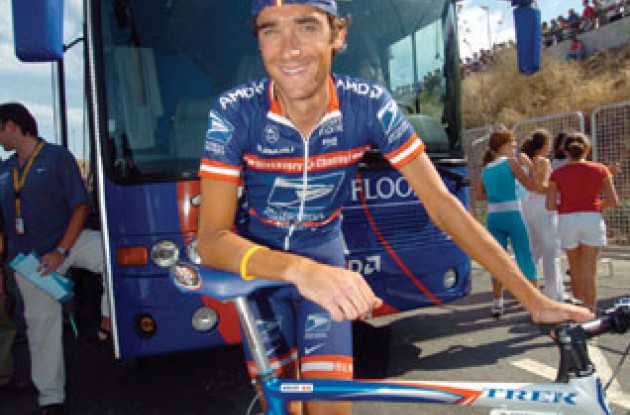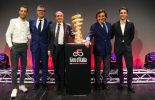Book Excerpt: Michael Barry's Inside the Postal Bus
The first time I saw the bus, I was both impressed and nervous. It was my first trip with the team in
?How do you like the 1980s strip club?? Christian asked.
The bus has a gray, blue, and red interior and exterior, is covered with logos on the outside, and lined with gray leather chairs with red trim on the inside. In the front there are 12 seats, two pair facing the front window and two sets of four facing each other with a table in between. The tables are rarely used for much other than a leg rest. Two long benches stretch toward the back of the bus, about 4 meters in length. After a race has ended and we?re driving to a hotel, every seat is filled by eight riders and a director.
Lance always takes the corner spot on the back bench, a spot where you can see everything going on in the rest of the bus and also a comfortable spot where you can put your legs up. When he?s not there, George takes that seat, and when George isn?t there nobody else really seems to care who has it.
For some reason the Spanish guys always seem to sit in the front of the bus, sprawled over the chairs, whereas all the other guys like the couches in the back. In the 2003 Vuelta, it became the joke that the front half of the bus was for the guys doing well, Triki and Roberto, and the rest of us were at the back of the bus where we had been all day on the climbs. None of the seats on the bus are used in a normal fashion. Most of the time legs are up in the air, guys are stretched out, and bags of clothing are scattered. Some packs become pillows while others become footrests.
Everybody gets ready at the same time and the bus becomes a zoo. Backpacks of race clothing are opened, with gear spilling out?numbers, jerseys, shorts?everything that we need for racing. Riders punch the buttons of the coffee machine while others push to get to the race food. Sugar, milk, creamer, condensed milk, and stir sticks all sit beside the automatic machine. Luc and the soigneurs take care of the coffee machine, while the rest of us abuse it and demand that it supply our needs with no complaints, and when it doesn?t, we call on them to remedy the situation. Cakes of different kinds?apple tarts, rice tarts, jam tarts, and small rolls or paninis filled with Nutella or jam?sit in paper bags next to the coffee machine. We can choose between a huge variety of Clif Bars, cakes, and Clif Energy Gels?all sugary and all fuel for the day?s efforts. Sometimes they?re hard to get down and other times they taste like the candy bars my allowance was saved for as a kid.
The cakes come from
Cereals are packed away in the shelves of the bus for the trips home from the races. Soy milk, for the lactose-intolerant, is in the fridge beside the sweetened condensed milk for the coffee.
Tucked away in one of the storage bins on the bus is an ultrasound machine. In the early season it seems the ultrasound machine is always out and riders are lining up to use it in the soigneurs? room. While one rider is on the massage table, another will be sitting on a bed using the ultrasound on his knee while another rider roots through the food bin looking for a cookie or piece of fruit. MTV, CNN, or Eurosport is usually on the television as background noise.
In the bus there are also bags of ice and ice packs, which we tuck under our tights or place over our knees, necks, or any other part that aches from the race. It?s not uncommon for us to be spread out across the body of the bus, nursing our aches in hopes of better muscles the next day.
The kitchen is beside the shower that is beside the bathroom. On the way to the races all of the doors separating the different compartments need to be closed, as the stench that comes out of the toilet is unbearable for the passengers. Most musicians have a ?no number two rule? on their tour buses for good reason, whereas we pretty much have a bus so we can take care of number two before a race. On a bumpy, sinuous mountain road, the stench is even worse as the corners seem to stir odors up from the depths of the bus. The soigneurs do their best to keep the bathroom and shower clean, but there are odors they can?t remedy, even with all the air fresheners and antibacterial sprays available.
Cyclists are generally not clean and neat right before or after a race. The bus is a sty after everybody has scurried and pushed about in an effort to get ready. After the race all anybody cares about is consuming calories and putting their feet up. When we arrive at the hotel for the evening, from the front to the back of the bus there are wrappers and open empty cans and bottles rolling around on the carpeted floor. It was really nice to have Berry Floor as a sponsor?they would replace the carpeting when it became nasty with stains.
During the few years I spent racing with the U.S.?based Saturn cycling team, we had no bus or camper, so we often had an issue finding toilets prior to the races. In
The team buses, like the mechanics? trucks, often get shuffled around between teams. When a team folds, another team will buy its bus or truck, or when a team upgrades their truck, a team with a smaller budget might buy the old truck. All the vehicles end up getting worked over during the season. They are cleaned and well cared for but they do rack up at least a few trips around








